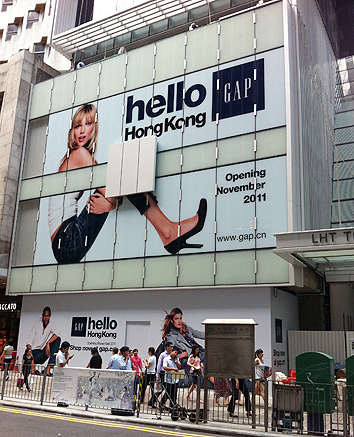Bev and I are big fans of Shanghai Tang, while Zen is a frequent shopper of Abercrombie & Fitch. We felt the following article in the Financial Times is quite interesting in terms of the two retail company's location in Hong Kong. - RL
Hong Kong Shops Look to the Mainland
Tsui, Enid. "Foreign Retailers defy Hong Kong Rent Surge." Financial Times. 11/30/11
MONGOLIAN yurts on a ferry pier may be a strange sight for Hong Kong commuters, but they are a telling symbol of the city's shifting retail landscape.
The yurts are the temporary home of Shanghai Tang, the luxury brand and Richemont subsidiary which has just lost its 13-year-old flagship store in a downtown colonial building to Abercrombie & Fitch, the US fashion chain.
"We are in-between stores. We have become the nomads of the Central district," says Raphael le Masne de Chermont, executive chairman of Shanghai Tang.
The Hong Kong retailer lost out because Abercrombie & Fitch offered the landlord about $1m in rent per month, three times more than Shanghai Tang was paying, real estate agents say.
The US retailer is part of an influx of foreign mid-range retailers defying an average 25% increase in retail rent this year to set up shop in the city in an effort to snare the big-spending mainland shopper.
According to CBRE, the real estate agency, retailers in Hong Kong are this year paying on average about $1,700 per square foot per year in prime locations, just behind prime areas in Manhattan, the world's most expensive district, where landlords charge $1,900 per square foot. Sydney is in third place at $1,224 per square foot.
Gap, the US clothing retailer, opened its first Hong Kong store last Friday, while fellow US retailers American Eagle Outfitters has already opened and Forever 21 is putting the finishing touches to its first store. Zara and H&M, the European companies, meanwhile, opened in Hong Kong in 2004 and 2007 respectively.
Hong Kong's retail market is tiny compared with the estimated $2,200bn in China's total retail spending last year.
However, it is the sheer number of shoppers coming from north of the border that represent Hong Kong's main appeal.
In 2010, 23m visitors came to Hong Kong from mainland China, a 25 per cent increase on the previous year, and they spent about $13bn in the city, according to the local tourism board. That is 17 times more than the amount Chinese tourists spent in France in the same period.
Hong Kong recorded $42bn in retail sales last year, up from $39.9bn in 2009.
Their number has increased by 17-28 per cent over the previous six quarters alone, year-on-year, according to government statistics. Competition is so intense that retailers are struggling to find the right kind of shop space. Many of the best spots are already taken up by luxury brands. Tiffany, Louis Vuitton, Armani, and other high-price brands were among the first western retailers to set up flagship stores in Hong Kong in the early 2000s with a firm eye on mainland Chinese demand.
With more than 90 per cent of global luxury brands already in the city, the latest entrants tend to come from the mid-range segment, according to CBRE, the real estate consults. Gap's new 15,000 sq ft, four-story shop in Queen's Road, the busiest thoroughfare in the business district, was opened just weeks after the group announced a 20 per cent cull of its North American network amid a sales slump there.
Mr. le Masne de Chermont adds: "Hong Kong is the most capitalist place in teh world, and it's all about survival. Retailers new to the market will soon find out that if they don't do well, they will end up working for their landlords."


No comments:
Post a Comment